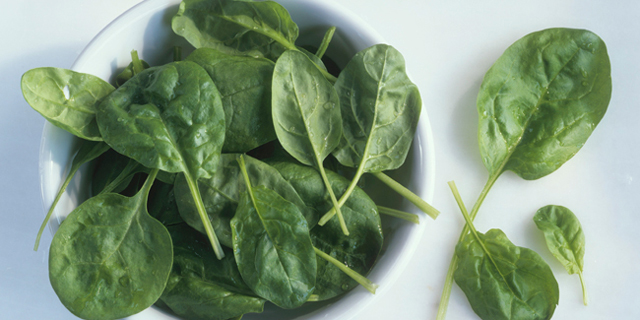Hailing from the same family as nutrient dense beets, quinoa, and chard, spinach is a household staple for its bright color, fresh taste, and richness in both vitamins and minerals. One cup of spinach contains astounding amounts of antioxidants including Vitamin A, Vitamin E, and Vitamin C which together support healthy vision and cell turnover. Spinach is also rich in bone supporting Vitamin K, calcium, and manganese, which means that Popeye was right. Spinach does do the body good!
How do I pick the best spinach?
Spinach comes in three varieties: savoy, semi-savoy, and flat leaf. These varieties are most easily distinguished by the leaves. Savoy varieties have deeply crinkled leaves, semi-savoy are a bit less crinkled, and flat-leaf is crinkle free. Because flat leaf is so much easier to clean and process, it is the variety most commonly found at the market. No matter the variety, look for leaves that have a vibrant and deep green color and stems that appear crisp and firm with no sign of yellowing. Leaves should be soft and tender, showing no signs of bruising or browning. Grit, dirt, or sand on the leaves is fine, but do avoid any bunches that are sticky or slimy indicating early spoilage.
What can I make with spinach?
Spinach is a very versatile ingredient. You’ve had it on your favorite sandwich, tossed into a delicious salad, and sprinkled into a savory frittata. Spinach can be boiled, sautéd, braised, or enjoyed raw. Simply sauté spinach with garlic and olive oil for a tasty side, blend into your morning smoothie, or add to a warm salad for extra color and nutrition. From breads and soups to smoothies and burgers, spinach is a great way to green your day one dish at a time.
To start cooking with spinach you first need to prep it. Fresh spinach is a magnet for dirt and grit. To clean fresh spinach, first chop off stems then fill up a large bowl with warm water and gently swish the leaves in it. Do this a few times, changing the water between each dunk, until leaves are clean and grit free. Then toss in as needed. To julienne, wrap up the leaves as you would a cigar and slice into ribbons. If you pick up a bag of prewashed spinach, just give it a quick rinse before use.
Fresh spinach is best stored wrapped in paper towel then placed in a zip-lock bag with excess air removed. Stored in the crisper it will keep fresh for up to a week. Remember not to wash or trim spinach until right before use. To freeze, simple puree clean spinach with a bit of water, transfer to a freezer-safe container, and use within one year.
Recipes to try include: Chorizo and Spinach Strudel, Spinach Mango Strawberry Smoothie, and Pan Verde.


![Making Mealtime Matter with La Familia: Easy Sofrito [Video]](https://thelatinkitchen.com/wp-content/uploads/2015/10/sofrito-shutterstock__0-500x383.jpg)
![Easy Latin Smoothies: Goji Berry Smoothie [Video]](https://thelatinkitchen.com/wp-content/uploads/2015/12/goji_berry-shutterstock_-500x383.jpg)
















![Fun and Fast Recipes: Fiesta Cabbage Salad [Video]](https://thelatinkitchen.com/wp-content/uploads/2015/11/fiesta_cabbage_slaw-shutterstock_-500x383.jpg)









